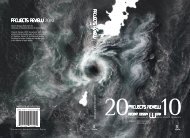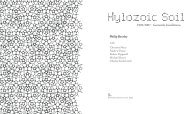The Inner Studio - Riverside Architectural Press
The Inner Studio - Riverside Architectural Press
The Inner Studio - Riverside Architectural Press
Create successful ePaper yourself
Turn your PDF publications into a flip-book with our unique Google optimized e-Paper software.
PART TWO | THE CREATIVE INSTINCT<br />
comes more slowly. Insight arrives with a kind of velocity, and<br />
needs to be treated as something precious. You have a chance to<br />
actually learn something from your insight. Before it arrives, you<br />
have never met it before; you have been waiting for its arrival,<br />
nonetheless it is a surprise. How can you learn about the insight?<br />
Try exploring a relationship with it. Treat it like a newfound friend.<br />
Ask it questions about itself. Ask yourself questions about it. What<br />
are its implications? Another insight may arise, and then, through<br />
the answer, understanding arises. Understanding involves us in<br />
patiently or steadfastly listening, assimilating, and digesting.<br />
Insight without understanding will leave us stuck and our work<br />
will seem not fully formed.<br />
Understanding makes us feel whole and happy. When we<br />
understand something, others naturally recognize this and often<br />
are drawn to ask about it. We don’t have to force the understanding<br />
on others; they will naturally be attracted to its contents. So<br />
another characteristic of understanding is that it benefits many<br />
people–it is naturally harmonizing. <strong>The</strong> door of understanding,<br />
once open to us, is naturally there for others to experience through<br />
the way it is embodied in our work. Understanding brings an<br />
exemplary quality to our design work. It is a kind of beauty that<br />
lingers like a deep porch overlooking a garden.<br />
Stabilizing the idea<br />
A key moment in the life of any creative project occurs very early<br />
in its development. This is the moment immediately after the<br />
design is born, when the designer needs to begin developing his or<br />
her project. Remember that inspiration is something we receive–<br />
once we have received it, we need to become aware of the qualities<br />
that distinguish our work so that we can consciously develop them.<br />
At this stage of work we begin the tricky process of balancing inflation<br />
and humility, in which the authors must learn to both separate<br />
from and have affection for their designs. Becoming aware of the<br />
essence of your idea and analyzing its qualities is really the introduction<br />
of the ego into the creative process. Without this step we<br />
may never be able to develop the richness and complexity of our<br />
projects. Stabilizing the design involves the active acceptance of<br />
49





